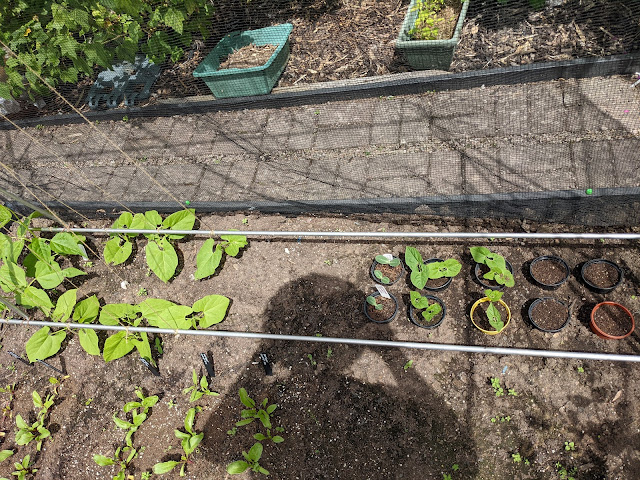We have been away for a short holiday in Mid-Wales, the Cambrian Mountains to be more precise. Consequently, we have been very busy in the garden since we got back. One of the many jobs was planting out the Sweetcorn.
 |
| Potato/Sweetcorn Plot |
In most years, I will pair sweetcorn with potatoes in the same plot. The potatoes have been in the ground for about two months and are growing well. Normally, I would sow sweetcorn indoors (late April), harden-off in the polytunnel (mid-May) for planting out in position in late May/early June. As with all things gardening, weather and other stuff often mean a change of plans.
This year, the first sweetcorn seed was sown on May 18th in 9 cm pots using Fertile Fibre Seed Compost. Germination (about 10 days) was a little slow, even in the polytunnel, due to a colder than usual May. I sow one seed per pot which allows the plant to develop a good root system with minimal disturbance when transplanting outside. Due to space limitations, I sow in batches of eight for successional harvesting during late summer/early autumn. Germination rates are typically 90% or more with fresh seed. This year I'm growing Incredible F1 from D.T. Brown.
As we planned to be away, I couldn't leave the pots with seeds or seedlings in the polytunnel because it would get too hot and they would dry out. Seven seedlings were planted directly into the ground inside a Hosta Halo (top of next photo taken on return from holiday). Pots with no obvious sign of germination were buried half-deep in the soil, again inside a Hosta Halo. Everything was well-watered in the hope there might also be some rain while we were away (spoiler alert: while it rained in Wales, it did not rain in Hereford!). Hosta Haloes are normally used for slug protection (unnecessary in this case because the soil had had a second Nemaslug treatment about a week before). However, they are also good for directing irrigation water around the roots where it is needed and ensuring the water goes deep into the soil - simply fill the halo with water and allow it to soak into the ground. As the photo below, taken on return from our holiday, shows: everything had thrived or survived.
 |
| Sweetcorn in Hosta Haloes |
 |
| Corn with strong tap root |
...they were transplanted into the ground by digging a hole six inches deep, filling the hole with two handfuls of homemade sieved compost...

.jpg)







0 comments:
Post a Comment